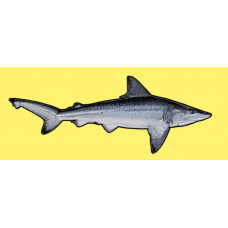Latin name
Carcharhinus hemiodon
Other name
Carcharhinus hemiodon
Identification
The Pondicherry shark has a rather thick body with a rather long, pointed snout. Each nostril has a nipple-shaped skin projection in front of it. The eyes are large and round. The mouth is curved, with no furrows at the corners. This species has 12-14 teeth on each side of both jaws and 1-2 small teeth on the symphysis (middle). The teeth are triangular in shape, with the upper teeth larger and angled compared to the lower teeth. The edges are slightly serrated. Placoid scales are oval in shape, scales overlap, scales have 3-5 ridges ending in spearheads.
Features of fish fins
Sickle-shaped pectoral fins with pointed ends originate below the fourth gill slit. The first dorsal fin is high with a characteristic elongated free tip behind it, the base of the fin is behind the tips of the pectoral fins. The second dorsal fin is long but low, opposite the anal fin. A low ridge runs between the first and second dorsal fins. The caudal peduncle has a deep crescent-shaped notch at the attachment point of the upper part of the caudal fin. The asymmetrical caudal fin has a well-developed lower lobe and a longer upper lobe with a notch on the posterior margin at the tip.
Fish colouring
The colouration of the Pondicherry shark is grey from the top, the belly is white and the white continues to the sides. The tips of the pectoral, second dorsal and tail fins are black, the other fins are darker towards the edges.
Distribution
Pondicherry sharks were widespread in the Indo-Pacific region, with individuals of this species occurring from the Gulf of Oman to the islands of Borneo and Java. There are also few records of their presence in the South China Sea, off New Guinea and northern Australia.
Habitat
This species is found in coastal waters. Several older sources report that it can be found in rivers such as the Hooghly and Saigon. These reports may have confused the river shark (Glyphis sp.) with the Pondicherry shark. If this is the case, we can assume that this species is tolerant of low salinity.
Size
The maximum size of sharks of this species has not been determined, but is probably not much over 1m.
Behavior
Little is known about the life and behavior of the Pondicherry shark.
Food and feeding habits
These sharks feed on small bony fish, cephalopods and crustaceans.
Reproduction
Presumably, like other members of the genus, it is a viviparous shark and the developing embryos are carried to term by a placental connection to the mother, although the exact details are not known. The size of newborns is approximately 32 cm in length. Sexual maturity occurs when they are over 60 centimetres long.
Fishing
Artisanal and commercial fishing in the Pondicherry shark's range is intense, unregulated and increasing. As a result, the International Union for Conservation of Nature (IUCN) has listed the shark as Critically Endangered (CR).
Relationship with a person
This is a very rare shark. There are less than 20 specimens in museum collections, most of which were collected before 1900. Despite detailed market surveys throughout most of its range, this shark was last seen in 1979.
| Classification | |
| Phylum | Chordata |
| Class | Chondrichthyes |
| Squad | Carcharhiniformes |
| Family | Carcharhinidae |
| Genus | Carcharhinus |
| Species | C. hemiodon |
| Features | |
| Conservation status | Critically Endangered |
| Habitat | Pelagic |
| Life span, years | No information |
| Maximum body weight, kg | No information |
| Maximum length, cm | 100 |
| Sailing speed, m/s | No information |
| Threat to people | Edible |
| Way of eating | Predator |
Pondicherry shark
Tags: pondicherry shark

